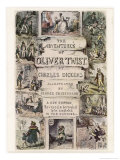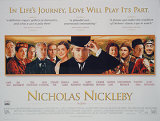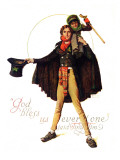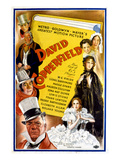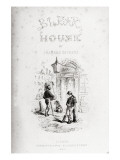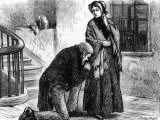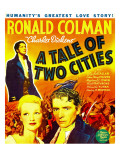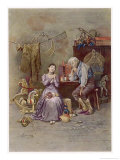|
|
Charles Dickens Posters, pg 2/2
for the language arts and social studies classrooms, home schoolers and Charles Dickens scholars.
|
literature > Charles Dickens Posters 1 | 2 < notable men < social studies
|
|
• CHARLES DICKENS POSTERS
Literature, Poetry and Language Arts
|
|
The Pickwick Papers - (1837) Members of the eponymous club recreate the ludicrous follies of nineteenth century England. Yet beneath the grotesqueries they chronicle runs a counterpoint of debtors' prisons, corruption and unreformed elections. With characteristic compassion and caustic satire, Dickens confronts the darker side of these charming anecdotes, in the novel that vaulted him from journalistic obscurity to literary pre-eminence.
• book cover posters
|
|
|
|
|
Oliver Twist- (1837-1838) Born and raised in the appalling deprivation of the workhouse, the orphan Oliver escapes the drudgery of apprenticeship only to fall into the hands of the notorious Fagin and his gang of child thieves. But Oliver is an innocent at heart and the attempts by Fagin and the impudently witty Artful Dodger to teach the boy the trick of the pick-pocket's trade lead only to his almost immediate capture. Oliver's rescue by the kindly Mr. Brownlow is only the beginning of a series of adventures that lead him to an incredible discovery.
• Bull's Eye, Bill Sikes Dog
|
|
|
|
Nicholas Nickleby- (1838-1839) Originally published in 20 monthly installments by “Boz”, and adapted to the stage before it was finished, this is a melodramatic tale of young man's adventures as he struggles to seek his fortune in Victorian England.• book cover posters
|
|
|
|
The Old Curiosity Shop (1841) The sensational bestselling story of Little Nell, the beautiful child thrown into a shadowy, terrifying world, seems to belong less to the history of the Victorian novel than to folklore, fairy tale, or myth.
The sorrows of Nell and her grandfather are offset by Dickens's creation of a dazzling contemporary world inhabited by some of his most brilliantly drawn characters-the eloquent ne'er-do-well Dick Swiveller; the hungry maid known as the “Marchioness”; the mannish lawyer Sally Brass; Quilp's brow-beaten mother-in-law; and Quilp himself, the lustful, vengeful dwarf, whose demonic energy makes a vivid counterpoint to Nell's purity.
|
|
|
|
A Christmas Carol- (1843) “Bah!” said Scrooge. “Humbug!” With those famous words unfolds a Dicken's tale that has become iconographic of Christmas.
Memorable characters are Ebenezer Scrooge, Tiny Tim, Bob Cratchit, and the Ghosts of Christmas Past, Present, and Future.
|
|
|
|
Life & Adventures of Martin Chuzzleewit- (1843) At the center of the novel is Martin –, very old, very rich, very much on his guard. What he suspects (with good reason) is that every one of his close and distant relations, now converging in droves on the country inn where they believe he is dying, will stop at nothing to become the inheritor of his great fortune.
• book cover posters
|
|
|
|
Dombey & Son - (1846) Paul Dombey is a heartless London merchant who runs his domestic affairs as he runs his business. In the tight orbit of his daily life there is no room for dealing with emotions because emotion has no market value. In his son he sees the future of his firm and the continuation of his name, while he neglects his affectionate daughter, until he decides to get rid of her beloved, a lowly clerk.
|
|
|
|
David Copperfield - (1849-50) The first of Dickens's novels written entirely in the first person. Converting his autobiographical impulse into fiction allowed
Dickens to explore uncomfortable truths about his life. David Copperfield's time at Murdstone and Grinby's warehouse, his schooling at Salem House, and his relationship with Dora all have their bases in Dickens's own life.
|
|
|
|
Bleak House- (1852) Dickens's most daring experiment in the narration of a complex plot, challenges the reader to make connections – between the fashionable and the outcast, the beautiful and the ugly, the powerful and the victims.
Nowhere in Dickens's later novels is his attack on an uncaring society more imaginatively embodied, but nowhere either is the mixture of comedy and angry satire more deftly managed.
|
|
|
|
Hard Times - (1854) Written deliberately to increase the circulation of Dickens’s weekly magazine, Household Words, Hard Times was a huge and instantaneous success upon publication in 1854. Yet this novel is not the cheerful celebration of Victorian life one might have expected. Compressed, stark, allegorical, it is a bitter exposé of capitalist exploitation during the industrial revolution – and a fierce denunciation of the philosophy of materialism, which threatens the human imagination in all times and places.
|
|
|
|
Little Dorrit - (1855) When Arthur Clennam returns to England after many years abroad, he takes a kindly interest in Amy Dorrit, his mother’s seamstress, and in the affairs of Amy’s father, William Dorrit, a man of shabby grandeur, long imprisoned for debt in the Marshalsea.
As Arthur soon discovers, the dark shadow of the prison stretches far beyond its walls to affect the lives of many, from the kindly Mr. Pancks, the reluctant rent-collector of Bleeding Heart Yard, and the tipsily garrulous Flora Finching, to Merdle, an unscrupulous financier, and the bureaucratic Barnacles in the Circumlocution Office. A masterly evocation of the state and psychology of imprisonment, Little Dorrit is one of the supreme works of Dickens’s maturity.
|
|
|
|
A Tale of Two Cities (1859) is set in the late 18th century against the background of the French Revolution.
When the three exiles: Dr. Manette, falsely imprisoned for decades; his daughter, Lucie, whose stunning beauty was matched by her loyalty and grace; and Charles Darnay, who abandoned a royal title he hated to risk being called a traitor in France and a spy in England, returned to Paris and the Reign of Terror, they were trapped in a bloodbath. Together, their love touched the hearts of even stodgy banker Mr. Lorry and cynical, jaded lawyer Sydney Carton.
|
|
|
|
Great Expecations - (1860-61) The adventures of an orphaned young man in Victorian England who is given a great deal of money by an unknown benefactor to enable him to live as a gentleman, pursuing a good education and fulfilling great expectations.
|
|
|
|
The Cricket on the Hearth
|
|
|
|
|
|
|
Our Mutual Friend - (1864) In the last of Dickens' completed novels, a bitter love triangle, a mysterious inheritance, and power of money motivates, frustrates and activates the characters to a bitter end – a witty indictment of a society fallen prey to the dawning age of commercialism.
The Mystery of Edwin Drood - (1870) When young Drood mysteriously disappears from his quiet cathedral town of Cloisterham, foul play seems certain. The prime suspect, John Jasper, Edwin's uncle, frequents opium dens and conceals a secret passion beneath his church choir respectability. Who did it?
|
|
• more Authors posters
|
|
previous page | top
|
|
I have searched the web for visual, text, and manipulative curriculum support materials - teaching posters, art prints, maps, charts, calendars, books and educational toys featuring famous people, places and events - to help teachers optimize their valuable time and budget.
Browsing the subject areas at NetPosterWorks.com is a learning experience where educators can plan context rich environments while comparing prices, special discounts, framing options and shipping from educational resources.
Thank you for starting your search for inspirational, motivational, and educational posters and learning materials at NetPosterWorks.com. If you need help please contact us.
|
|
|








